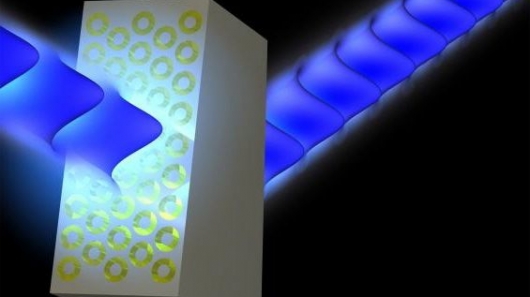New metamaterial could lead to more efficient solar cells
By Ben Coxworth
20:17 May 10, 2010

Metamaterials are manmade substances designed to do some very weird things that natural materials don’t. The path of a beam of light through a natural material like glass is predictable, but scientists from the California Institute of Technology (Caltech) have engineered an optical material that bends light in the wrong direction. This new negative-index metamaterial (NIM) could have several valuable uses including invisibility cloaking, superlensing (imaging nano-scale objects using visible light) and improved light collection in solar cells.
This is not the first time such a material has been developed, but it is the first one that can handle light of any polarity, from any angle. It also works in the blue part of the visible spectrum, making it the first NIM to operate at visible frequencies.
Previous NIM’s have used used multiple layers to wrongly refract light. The Caltech material, by contrast, utilizes just one layer of silver permeated with "coupled plasmonic waveguide elements.” Basically... plasmons are light waves, which get coupled to waves of electrons at the point where the silver meets the air. The waveguide elements then guide these plasmon/electron waves through the material.
This relatively simple material would be much easier to produce than previous efforts. By changing its composition or waveguide geometry, the NIM could be tuned to respond to different wavelengths, coming from almost any angle with any polarization. This quality makes it particularly well-suited to use in solar cells.
“The fact that our NIM design is tunable means we could potentially tune its index response to better match the solar spectrum, allowing for the development of broadband wide-angle metamaterials that could enhance light collection in solar cells,” explained team leader Harry Atwater. “The fact that the metamaterial has a wide-angle response is important because it means that it can 'accept' light from a broad range of angles. In the case of solar cells, this means more light collection and less reflected or 'wasted' light.”
Caltech’s research was recently published in Nature Materials.
Copyright © gizmag 2003 - 2010 To subscribe or visit go to: http://www.gizmag.com